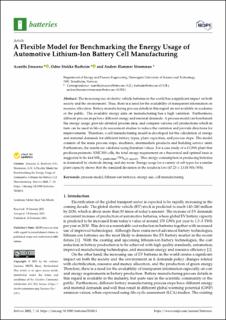| dc.description.abstract | The increasing use of electric vehicle batteries in the world has a significant impact on both society and the environment. Thus, there is a need for the availability of transparent information on resource allocation. Battery manufacturing process details in this regard are not available in academia or the public. The available energy data on manufacturing has a high variation. Furthermore, different process steps have different energy and material demands. A process model can benchmark the energy usage, provide detailed process data, and compare various cell productions which in turn can be used in life-cycle assessment studies to reduce the variation and provide directions for improvements. Therefore, a cell manufacturing model is developed for the calculation of energy and material demands for different battery types, plant capacities, and process steps. The model consists of the main process steps, machines, intermediate products and building service units. Furthermore, the results are validated using literature values. For a case study of a 2 GWh plant that produces prismatic NMC333 cells, the total energy requirement on a theoretical and optimal basis is suggested to be 44.6Whinproduction/Whcellcapacity. This energy consumption in producing batteries is dominated by electrode drying, and dry room. Energy usage for a variety of cell types for a similar plant capacity shows that the standard deviation in the results is low (47.23±13.03Wh/Wh). | en_US |

